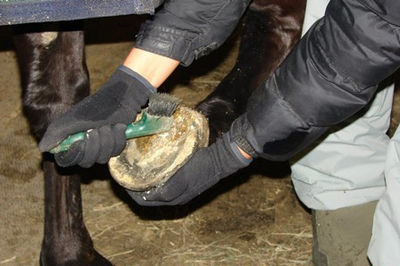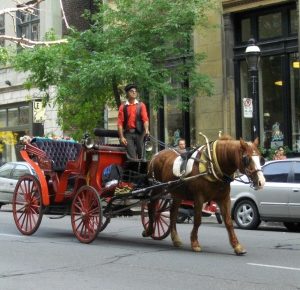 |
Horses spend most of their lives standing on their feet and hooves which is why it is so important to keep them in the best shape possible.
The ancestor of the horse, eohippus, had 4 toes. As horses evolved, they developed into one-toed animals, but evidence remains of the other toes.
A horse’s hoof is the hard outside covering of the foot. The hooves, while appearing solid are actually layered. There are 3 bones within the hoof, the longest being the pedal bone. This bone carries blood vessels and nerves in tiny passages to other parts of the hoof. The next layer is the digital cushion, a rubbery pad forming the heel which help absorbs the pounding of hooves touching the ground. Next is the laminae which is surrounded by the visible portion of the hoof. There is a white line between the 2 layers, a margin which the farrier uses to determine how to trim the hoof. The parts of the visible hoof are called the wall, the sole and the frog.
A horse’s hooves need constant care to keep them healthy.
You will need a special tool called appropriately a hoofpick. Horses that are ridden daily or spend a lot of time confined should have their hooves cleaned daily, before and after riding.
In the wild, horses are constantly on the move and are able to wear down their hooves comfortably. However, since hooves grow continuously, domestic horses’ hooves need trimming every 6-8 weeks. A skilled farrier is the person to call on for the job. Someone who is untrained in care of the hoof can cause irreparable damage to the horse. In choosing a farrier you want the best for your horse.
Work horses or horses who run on hard ground regularly need shoes. Shoes should be properly fitted by a farrier. Your farrier or veterinarian can assess whether your horse should be shod. The shoes have to be removed and checked every 6-8 weeks. If left on too long, they can cause damage to the hoof.
Proper hoof care should help avoid problems. But you should be aware of problems that can arise.
Cracks – These can start at the top or bottom of the hoof. Cracks starting at the top of the hoof can indicate something wrong in hoof growth. Cracks beginning at the bottom of the hoof can mean hoof walls are dry or thin or have not been trimmed properly.
Thrush is an infection of the frog. Consult with your veterinarian or farrier for information on treatment.
Canker, also known as hoof rot is an infection of the entire foot. You can recognize it by the foul odor and a discharge. Your horse should be seen by the vet as soon as possible.
Abscesses – Sudden lameness can indicate an abscess. Causes can be bruising, a corn or a wound. The abscess needs to be drained by your vet who will explain what further treatment is necessary. Your horse may need a tetanus shot as well.
Laminitis, also referred to as founder, is an extremely painful inflammation of the foot. It usually affects the front legs but can occur in back legs too. Feeding too much grain is one cause of the problem. Your vet needs to see your horse as soon as possible. Ongoing studies of laminitis at Texas A & M University researching risk factors, management and prevention, hope to stop this painful, debilitating condition from ever occurring.
Corns can appear due to constant pressure on a particular spot. They can be caused by improperly fitted shoes or shoes left on too long.
Bruises can be caused by trauma to the foot, such as a blow or stepping on a stone. If your horse bruises often, it may be necessary to use protective shoes and pads. Consult with your farrier or veterinarian.
Navicular Syndrome is off and on lameness for no apparent reason. Pain is caused by the inflammation or degeneration of the navicular bone, a small bone inside the foot and surrounding tissue.
White Line Disease or Seedy Toe can take months before obviously affecting the hooves. The area of the hoof wall becomes dry and crumbly.
Learn to recognize when your horse is not acting normally. Checking your horse’s hooves and feet daily can help avoid or treat problems before they become serious.
Related Articles



